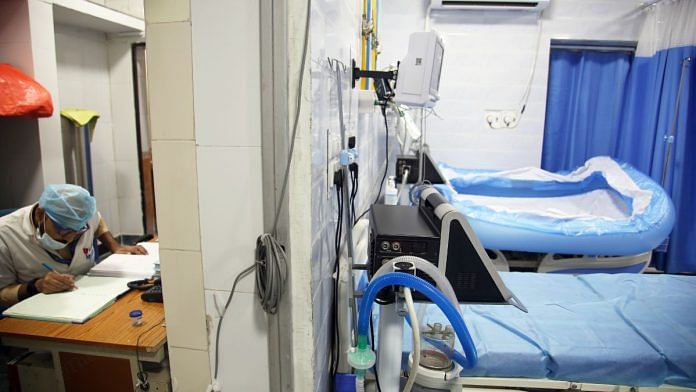New Delhi: Despite the marked rise in suspected heatstroke cases in 2024, 68 percent of India’s government hospitals lacked cooling facilities to treat heat-related illnesses, a new government report has revealed.
The report on Heat-Health Preparedness & Response Activities was put together by the National Programme on Climate Change & Human Health, which falls under the Union health ministry’s National Centre for Disease Control (NCDC) and was released last week.
Seen by ThePrint, the report says 48,156 suspected heatstroke cases, 269 suspected and 161 confirmed heatstroke deaths were reported across the country in 2024.
The year 2024 was the hottest year on record and the first when temperatures were 1.5°C above pre-industrial levels.
Daily indicators such as emergency visits, total and cardiovascular deaths at the facilities were reported to have increased last year, the report noted.
The 91-page document compiled the assessment of over 5,690 public health facilities at various levels—public health centres (PHCs), community health centres (CHCs), district hospitals and medical colleges—between April and July last year. The facilities were checked for the availability of basic utilities, oral rehydration solution (ORS) corners, diagnostic equipment, and emergency cooling equipment or appliances, apart from ambulances.
It showed that while 99 percent of the hospitals had ORS corners, 84 percent had basic utilities, 74 percent had completed training of health personnel for clinical management of heatstroke cases and surveillance reporting, and only 32 percent had emergency cooling preparedness.
In March last year, the Union health ministry had asked public health facilities across states to set up ‘heat clinics’.
These special wings, the Centre said, would be responsible for procurement and supply of adequate quantities of ORS packs, essential medicines, IV fluids, ice-packs, and other equipment crucial to stabilise and treat heat exhaustion and heatstroke patients. Ideally, these units should be equipped with two ceramic tubs, a 200 kg ice-making machine, ice boxes, rectal thermometers, and inflatable tubs that can also be sent out in ambulances, say experts.
“Considering that a national level initiative to equip hospitals for this climate change-related health emergency was started only in recent years—we have done a good job. However at the PHC and CHC levels—the preparedness needs to improve fast,” a senior NCDC official told ThePrint.
ThePrint also reached NCDC director Dr Atul Goel for comment via phone calls but did not receive a response by the time of publication. This report will be updated if and when a response is received.
Also Read: Prolonged heatwaves new normal in India & world, mitigation measures necessary — Moody’s report
How extreme heat strikes
Typical body temperature hovers around 37ºC (36.1–37.8ºC/ 96.98—100.04ºF), regulated by the thermo regulatory centre in the hypothalamus of the brain.
This centre maintains equilibrium between internal heat production and external heat exchange, primarily through sweat evaporation and some other methods, including convection, respiration, and conduction. However, doctors say, extreme temperatures and humidity impair efficient heat dissipation, while physical exertion generates internal heat, which, when coupled with environmental factors, can quickly lead to heat accumulation.
In case heat gain exceeds loss, the body temperature rises, triggering the hypothalamic regulatory system to prompt responses like sweating, peripheral vasodilation, and increased cardiac activity, redistributing blood from the body core to the skin to lower temperature.
Prolonged exposure to high temperatures and excessive sweating, however, can deplete salt and water levels, and inadequate replenishment of fluids and electrolytes can result in dehydration and hyponatremia. This can further lead to heat cramps, potentially progressing to heat exhaustion if left untreated.
Heat-related illnesses include a spectrum of conditions stemming from the body’s struggle to regulate heat. These can be minor ailments like heat edema, heat rash, cramps, tetany, syncope (fainting), and exhaustion, with heatstroke being the most severe manifestation, said a senior clinician in the internal medicine department of the All India Institute of Medical Sciences (AIIMS), Delhi. Heat exposure can exacerbate respiratory, cardiovascular, electrolyte, and renal issues, leading to mild to fatal outcomes, the doctor said.
Adding, “Since extreme heatwave conditions seem to be getting worse every year in most parts of the country, it is important for hospitals—mainly government ones—to be adequately prepared to cater to heatstroke patients.”
On a similar note, the NCDC report notes: “…as exposure to extreme heat increases, the need to provide on site cooling as well as pre-referral cooling at primary levels may increase. With this focus, ambulances, PHCs and CHCs may be further strengthened to provide such services.”
Reporting poor in most states
In 2024, on an average, 55 percent of reporting units shared data on heat-related illnesses to the NCDC’s centralized monitoring centre.
This is out of 47,477 reported in the National Heat-Related Illness and Death Surveillance (NHRIDS) set up in 2015 under the NCDC’s Integrated Disease Surveillance Programme.
While Gujarat, Odisha, Telangana remained high performing states with 91, 89 and 72 percent marked units reporting to the NHRIDS, reporting was poor from many states, including those worst impacted by heatwaves.
Nationally, a maximum reporting of 62 percent was observed between 15 May and 10 June 2024, which also coincided with peak heatwave days.
According to reports, Delhi experienced a warm February this year, with both maximum and minimum temperatures showing a rise compared to the previous year. The IMD, in its summer outlook for 2025 has predicted above-normal temperatures from March to May.
(Edited by Sanya Mathur)
Also Read: Over 10,000 deaths caused by heatwave in India between 2013 & 2022, most in Andhra Pradesh






